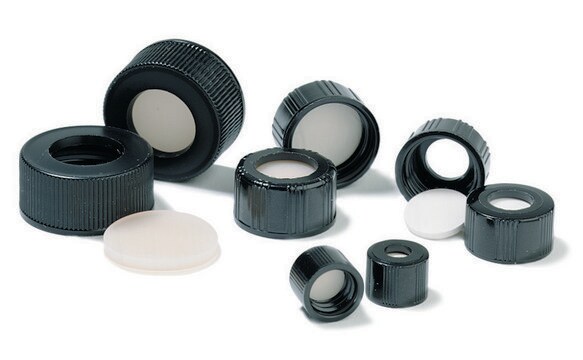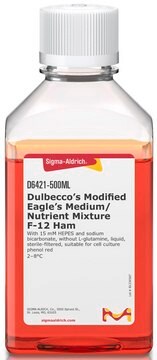推荐产品
产品名称
MCF10A CELLS CDH1 (-/-),
生物源
human female mammary glands (Source Disease: Fibrocystic Disease)
品質等級
OMIM登錄號
儲存溫度
−196°C
基因資訊
human ... CDH1(1105)
一般說明
MCF10A CELLS CDH1 (-/-) are pre-neoplastic mammary epithelial cells from a human adult female with a ZFN knock out modification.
This cell line corresponds to ATCC Catalog No. CRL-10317.
應用
Cell freezing medium-DMSO 1X, Cat. No. C6164
Media renewal changes two to three times per week.
Rapidly thaw vial by gentle agitation in 37°C water bath (~2 minutes), keeping vial cap out of the water. Decontaminate with 70% ethanol, add 9 mL culture media and centrifuge 125 x g (5-7 minutes). Resuspend in complete culture media and incubate at 37°
The base medium for this cell line is Dulbecco′s Modified Eagle′s Medium/Ham′s Nutrient Mixture F-12, Cat. No. 51448C. To make the complete growth medium, add the following components to the base medium: horse serum, Cat No. H1270, to a final concentration (v/v) of 5%; cholera toxin, Cat No. C8052, to a final concentration of 1 ng/mL; human insulin, Cat No. I9278, to a final concentration of 10 ug/mL; epidermal growth factor, Cat No. E9644, to a final concentration of 10 ng/mL; and hydrocortisone, Cat No. H6909, to a final concentration of 0.5 ug/mL.
特點和優勢
These MCF10A cells are adherent with a doubling time of approx. 48 hours
Zinc finger nuclease (ZFN) knockout on chromosome 16q22.1
品質
Tested for Mycoplasma, sterility, post-freeze viability, short terminal repeat (STR) analysis for cell line identification, cytochrome oxidase I (COI) analysis for cell line species confirmation.
免責聲明
RESEARCH USE ONLY. This product is regulated in France when intended to be used for scientific purposes, including for import and export activities (Article L 1211-1 paragraph 2 of the Public Health Code). The purchaser (i.e. enduser) is required to obtain an import authorization from the France Ministry of Research referred in the Article L1245-5-1 II. of Public Health Code. By ordering this product, you are confirming that you have obtained the proper import authorization.
仅试剂盒组分
产品编号
说明
- MCF10A CELLS CDH1 (-/-) 1 vial
儲存類別代碼
10 - Combustible liquids
水污染物質分類(WGK)
WGK 3
閃點(°F)
Not applicable
閃點(°C)
Not applicable
Henry Beetham et al.
Scientific reports, 9(1), 12511-12511 (2019-08-31)
The cell-cell adhesion protein E-cadherin (CDH1) is a tumor suppressor that is required to maintain cell adhesion, cell polarity and cell survival signalling. Somatic mutations in CDH1 are common in diffuse gastric cancer (DGC) and lobular breast cancer (LBC). In
Augustine Chen et al.
BMC cancer, 14, 552-552 (2014-08-01)
E-cadherin is an adherens junction protein that forms homophilic intercellular contacts in epithelial cells while also interacting with the intracellular cytoskeletal networks. It has roles including establishment and maintenance of cell polarity, differentiation, migration and signalling in cell proliferation pathways.
Nicola Bougen-Zhukov et al.
Cancers, 14(7) (2022-04-13)
The CDH1 gene, encoding the cell adhesion protein E-cadherin, is one of the most frequently mutated genes in gastric cancer and inactivating germline CDH1 mutations are responsible for the cancer syndrome hereditary diffuse gastric cancer (HDGC). CDH1-deficient gastric cancers exhibit
Lyvianne Decourtye-Espiard et al.
Cancers, 14(1) (2022-01-12)
Inactivating germline mutations in the CDH1 gene (encoding the E-cadherin protein) are the genetic hallmark of hereditary diffuse gastric cancer (HDGC), and somatic CDH1 mutations are an early event in the development of sporadic diffuse gastric cancer (DGC) and lobular
相关内容
We have applied our revolutionary CompoZr Zinc Finger Nuclease technology to create an unparalleled range of genetically modified mammalian cell lines for use in areas, such as target validation, drug discovery and drug development.
We have applied our revolutionary CompoZr Zinc Finger Nuclease technology to create an unparalleled range of genetically modified mammalian cell lines for use in areas, such as target validation, drug discovery and drug development.
我们的科学家团队拥有各种研究领域经验,包括生命科学、材料科学、化学合成、色谱、分析及许多其他领域.
联系技术服务部门








